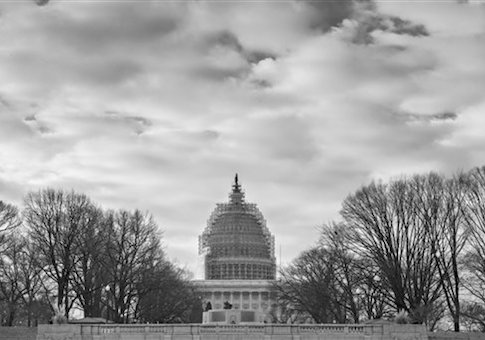Some lawmakers are considering a full-year continuing resolution to fund the government next year, a makeshift measure that would fail to address defense cuts and hamper procurement of new ships, planes, and vehicles, critics say.
If Congress fails to pass new appropriations bills for 2016, members could pursue a stopgap resolution, a common practice in recent years. However, many of the previous continuing resolutions (CR) have been short-term.
The prospect of a full-year CR has raised concerns among military leaders who must plan years in advance for acquisitions of new equipment. It would also lock in the base funding level from 2015 of $496 billion for the Pentagon—keeping it below the budget caps known as sequestration that have already drained billions from the Department of Defense budget.
About $64 billion would still be available for fighting wars abroad, known as Overseas Contingency Operations (OCO).
Justin Johnson, senior policy analyst for defense budgeting at the Heritage Foundation, said in an interview that a full-year CR would have a "real impact" on defense spending and procurement amid a period of global instability unseen since the Cold War. The 2015 spending level is about $38 billion less than President Obama’s budget request of $534 billion for 2016.
"We have already cut the defense budget by 15 percent in real terms in the last four years," he said. "Leaving it at the current level, instead of increasing it, doesn’t help the security situation."
Todd Harrison, senior fellow at the Center for Strategic and International Studies, told Defense News that a long-term CR "really creates havoc on programs, projects and activities in the Defense Department."
Several Air Force projects could be delayed, for example, including the Long Range Strike-Bomber program, the F-35A joint strike fighter, and future space equipment.
While the House has already passed a defense appropriations bill for next year, Senate Democrats have blocked the Republican-authored version in that chamber. Democratic leaders have urged their GOP counterparts to negotiate a compromise that raises the spending caps on both domestic and military funding.
Both the House and Senate defense bills keep base funding below the sequestration limits but add OCO funding to alleviate the cuts.
Despite reports that a full-year CR is a possibility, other lawmakers are working to prevent that outcome.
"While Democrats unfortunately have filibustered the bill, I don’t hear anybody advocating to fund the Defense Department at CR levels for a full year," said Stephen Worley, spokesman for the Senate Appropriations Committee. "The Defense Department has never operated under a full-year CR; we don’t intend to start now."
The outlook for defense spending going forward is a "messy situation," Johnson said. Obama previously threatened to veto the National Defense Authorization Act (NDAA), the annual military policy bill, unless budget caps were raised, but he might choose to sign the legislation next month in order to secure congressional support for the Iran nuclear deal.
Yet the actual defense spending bill, a separate piece of legislation, could still be held up by politics, Johnson said.
"After [the NDAA and Iran deal debates], the president will have more political capital to play with and less need to try and win Democrats to his side," he said.
Lawmakers might also attempt to work out a deal that raises spending caps along with the nation’s $18.1 trillion debt limit, which the government could reach in mid-November. Rep. Paul Ryan (R., Wisc.) and Sen. Patty Murray (D., Wash.), reached a similar agreement in 2013 that helped offset some of the sequestration cuts.
The military has downsized its forces and reduced training time to cope with sequestration, which could reduce the Pentagon’s budget by nearly $1 trillion over the course of a decade. The Army announced plans last month to shed 40,000 soldiers from its ranks, and the Navy has reduced its aircraft carrier presence in the volatile Persian Gulf due to repeated deployments and delayed maintenance.
Gen. Ray Odierno, the outgoing Army chief of staff, has said that the force cuts could make it difficult for the military to fight even one war—compared to the previous target of being able to fight two major theater wars simultaneously.
Johnson said it is unlikely Congress will take significant steps to reverse the defense cuts until the next presidential administration or something more ominous.
"Politics responds to headlines," he said. "A major terrorist incident, God forbid, or some sort of military action, something that really drives home the point that the world has been getting more dangerous in the past four years at the same time we’re cutting defense 15 percent, could lead to a new deal."
